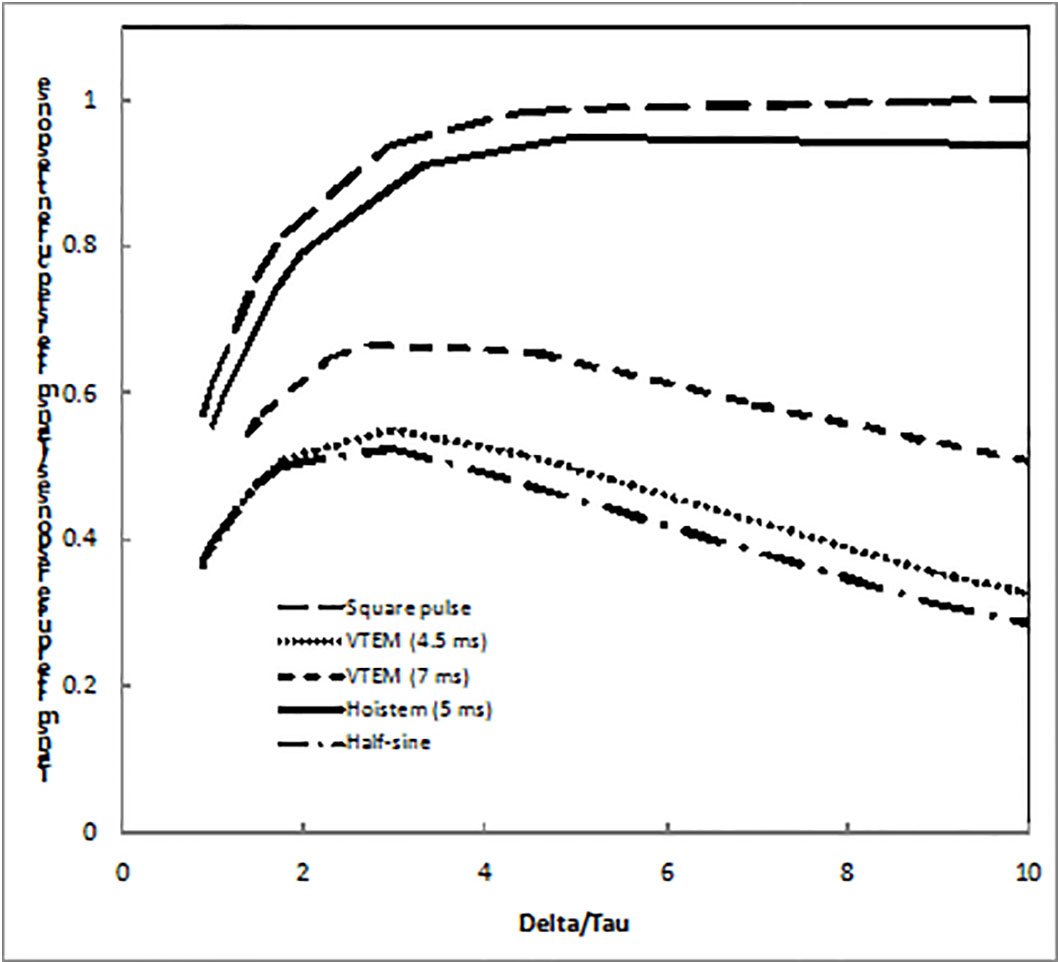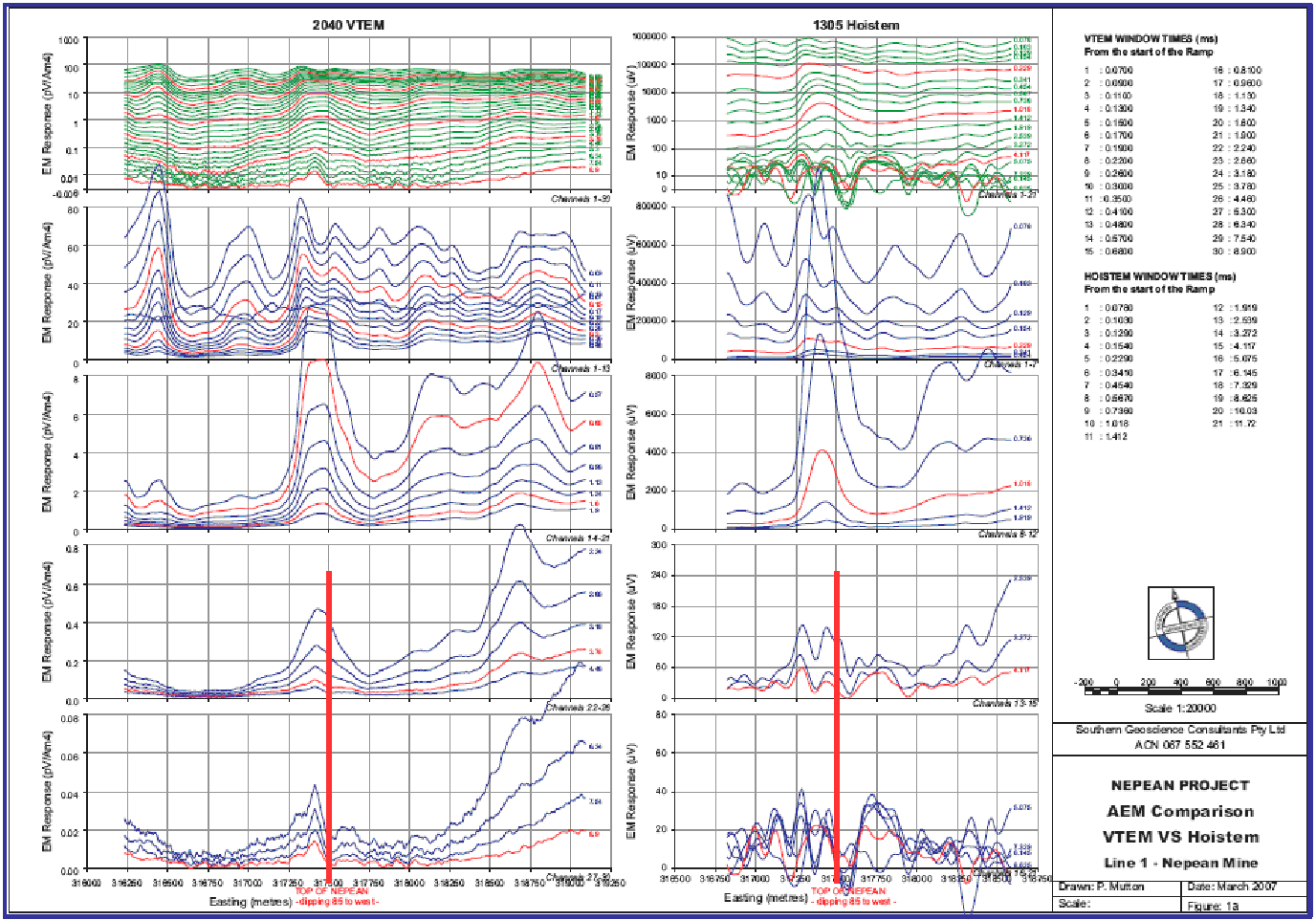Presented at AEM 2008, Haikko Manor, Finland
For a PDF of this paper click here
Abstract/Summary
In March 2007 a VTEM test survey was flown over the Nepean nickel project, Coolgardie, WA, Australia. The results from this survey are compared to the known geology as well as responses from ground surveys and a Hoistem survey over the same area.
Nepean Nickel Project
The Nepean nickel mine is located approximately 25km south of Coolgardie in Western Australia and was closed in 1987. The orebody is steeply dipping to the west at between 70-80 degrees. The know Nepean mineralisation consists of two bodies on a thrust repeated basalt-serpentinite contact that are separated by a few meters. Meta sedimentary units exist in the hanging-wall between the (serpentinised) ultramafic flows. Large late-stage sub-horizontal pegmatite dykes have intruded the area and cross cut (“stope out”) the nickel mineralization. Although the main orebody has been mined out, the area is being investigated for additional nickel resources.
In early 2004 a ground TEM survey was completed over the nickel mine to test for undiscovered nickel on adjacent basalt-ultramafic contacts to the east and west of the mineralised contact. This survey detected a very conductive unit that was adjacent to the Nepean Mine workings and is thought to be due to an 80m deep sulphide bearing carbonaceous shale unit located 30m to the west of the mineralised contact in the hanging wall. This survey also defined other discrete conductors along strike from the mine; however these were drilled and found to be massive pyrrhotite with no nickel sulphide. The Nepean ground EM survey demonstrated that the Nepean and adjacent conductors were clearly detectable less than 10ms after current turnoff.
Nepean Trial Airborne EM Surveys
In the Western Australian Goldfields, airborne EM surveys have not had any success in base metal discoveries. This is due to a combination of factors such as the deep depth of oxidation, conductive groundwater, and relatively (to ground EM) low signal to noise ratios in the available systems.
In many areas in the Goldfields the groundwater is not particularly conductive and the depth of oxidation in the Nepean area is only about 60m.
In late 2004, an area including the mine was over flown by a Hoistem helicopter EM system as a trial. The system did detect an anomaly coincident with the Nepean ultramafic. However, this anomaly disappeared at late times and was interpreted to be due to deeper weathering over the serpentinite. No basement conductor was identified. Similarly the massive sulphide along strike from the Nepean Mine was not identified, although there was also an anomaly associated with the deeper weathering over the ultramafic that disappeared with late times.
In early 2007, the area was re-flown with the VTEM system. This survey’s results clearly showed a basement conductor adjacent to the Nepean Nickel Mine coincident with the ground EM conductor and also detected the massive sulphide conductors along strike from the mine.
Figure 1 shows a comparison of the two systems over Line 1. At late time channels (times later than 5 milliseconds), the bedrock conductor is clearly visible on the VTEM data and a steep dip to the left of the profile can be interpreted. The VTEM data contains valid responses to the last channel at about 10 milliseconds after turn-off. It appears that the Hoistem data has reached its noise floor at about 4 or 5 milliseconds and consequently the bedrock conductor is not detected.
Due to the minimum 3km line length, the VTEM survey lines extended beyond the limits of the ground EM surveys, and in the south, detected 4 more discrete conductive units that had not been identified in the Hoistem survey.
Discussion
In many respects, the VTEM and Hoistem helicopter TDEM systems are very similar. Table 1 lists the most common survey parameters of each. They have similar size transmitter loops (24m for Hoistem versus 26 m for VTEM), are in-loop systems and both operate at 25 Hz. VTEM enjoys a larger dipole moment and uses a slightly longer transmitter pulse. For the Nepean survey a current of 155 A (translating to peak dipole moment of 329 000 NIA), pulse width of 8.81 ms and turn-off time of 1.27 ms were implemented.
A comparison of the VTEM (7 ms) and Hoistem (5 ms) waveform responses was done following Liu’s methodology (1998) of convolving transmitter waveforms with a target response approximated by a single exponential decay. Also included as reference are responses from an idealized step current, square current pulse, a half-sine and a VTEM (4.5) ms waveform. The Hoistem pulse was approximated from Boyd (2004) and reflects the essence of the pulse width and very fast turn-off time. VTEM pulses are as measured during actual surveys and the rest are calculated as described by Liu (1998). Figure 2a shows the different transmitter pulse responses as a ratio of the idealized step current. All waveforms are normalized to 1 A peak current and are presented as a function of pulse width divided by target time constant (Δ/τ). It is clear that the Hoistem waveform is the most efficient waveform, coming very close to the idealized square pulse response. However, the effective dipole moment of a system must also be taken into account and when this is done (Figure 2b) the VTEM (7 ms) response is higher than Hoistem (5 ms).

Figure 2: (a)Ratio of the response for a selected transmitter pulse to that of the step current as a function of Δ/τ. (extended from Liu 1998). (b) Normalised VTEM and Hoistem responses multiplied with the respective peak dipole moments to give the effective system responses.
Conclusion
The Nepean Nickel project includes several massive sulphide conductors in an area with very little outcrop and oxidation to 60m. These conductors have been considered a challenge for AEM systems but were mapped successfully with VTEM in 2007.
Acknowledgements
The authors would like to thank Focus Minerals Ltd for their permission to publish this data and the assistance of Stewart Capp and James Macnae in the preparation of this paper.
References
Boyd, G.W., 2004, HoisTEM – a new airborne electromagnetic system: PACRIM Proceedings, Adelaide.
Liu, G., 1998, Effect of transmitter current waveform on airborne TEM response: Exploration Geophysics 29, 35–41.
WorleyParsons-GPX Pty Ltd, Available: http://www.curnamona-energy.com.au/pdf/Description%20of%20HoistEM.pdf [Accessed April 2008].

